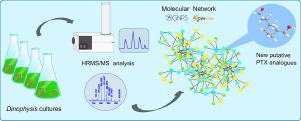Harmful Algae ( IF 5.5 ) Pub Date : 2021-03-31 , DOI: 10.1016/j.hal.2021.102026 Manoëlla Sibat , Damien Réveillon , Chloé Antoine , Liliane Carpentier , Georges Augustin Rovillon , Véronique Sechet , Samuel Bertrand

|
Some species of the genus Dinophysis contain Diarrhetic shellfish Poisoning (DSP) toxins and are the main threat to shellfish farming in Europe including France. Dinophysis species are known to produce two families of bioactive lipophilic toxins: (i) okadaic acid (OA) and their analogues dinophysistoxins (DTXs) and (ii) pectenotoxins (PTXs). Only six toxins (OA, DTX1, DTX2, DTX3, PTX1 and PTX2) regulated by the European Union Legislation (EC No. 15/2011; 3) are routinely monitored using targeted chemical analysis by liquid chromatography coupled to mass spectrometry (LC-MS/MS) while toxic species of Dinophysis produce many other analogues. To tentatively identify unknown toxin analogues, a recent approach (Molecular Networking, MN) was used based on fragmentation data obtained by untargeted high resolution mass spectrometry (HRMS). An optimization of the data-dependent LC-HRMS/MS acquisition conditions was conducted to obtain more informative networks. The MN was applied to provide an overview of the chemical diversity of four strains belonging to three major Dinophysis species isolated from French coastal waters (D. acuta, D. caudata and the “D. acuminata complex” species D. acuminata and D. sacculus). This approach highlighted species-specific chemical patterns and also that Dinophysis chemical diversity is largely unexplored. Using MN allowed to identify directly known toxins and their relationship between species of Dinophysis, leading to the discovery of five new putative PTX analogues.
中文翻译:

分子网络作为一种新颖的方法来揭示法国沿海水域的四种主要Dinophysis物种的毒素多样性
属的一些种类鳍藻含有腹泻性贝毒(DSP)和毒素对贝类养殖在欧洲,包括法国的主要威胁。鳍藻物种已知产生的生物活性亲脂性毒素两个家族:(ⅰ)冈田酸(OA)和它们的类似物dinophysistoxins(DTXs)和(ii)pectenotoxins(PTXs)。通过液相色谱与质谱联用(LC-MS)进行靶向化学分析,仅常规监测受欧盟立法(EC No.15 / 2011; 3)管制的六种毒素(OA,DTX1,DTX2,DTX3,PTX1和PTX2)。 / MS),而Dinophysis的有毒物种产生许多其他类似物。为了初步鉴定未知的毒素类似物,基于通过非目标高分辨率质谱法(HRMS)获得的碎片数据,使用了一种最新方法(分子网络,MN)。对数据相关的LC-HRMS / MS采集条件进行了优化,以获取更多信息网络。MN用于概述从法国沿海水域分离的三种主要Dinophysis物种(D. acuta,D。caudata和“ D. acuminata complex ”物种D. acuminata和D. sacculus)的四种菌株的化学多样性。)。这种方法强调了特定物种的化学模式,并且Dinophysis的化学多样性在很大程度上尚未得到开发。使用MN可以识别直接已知的毒素及其在恐龙生物物种之间的关系,从而发现了五个新的推定PTX类似物。











































 京公网安备 11010802027423号
京公网安备 11010802027423号